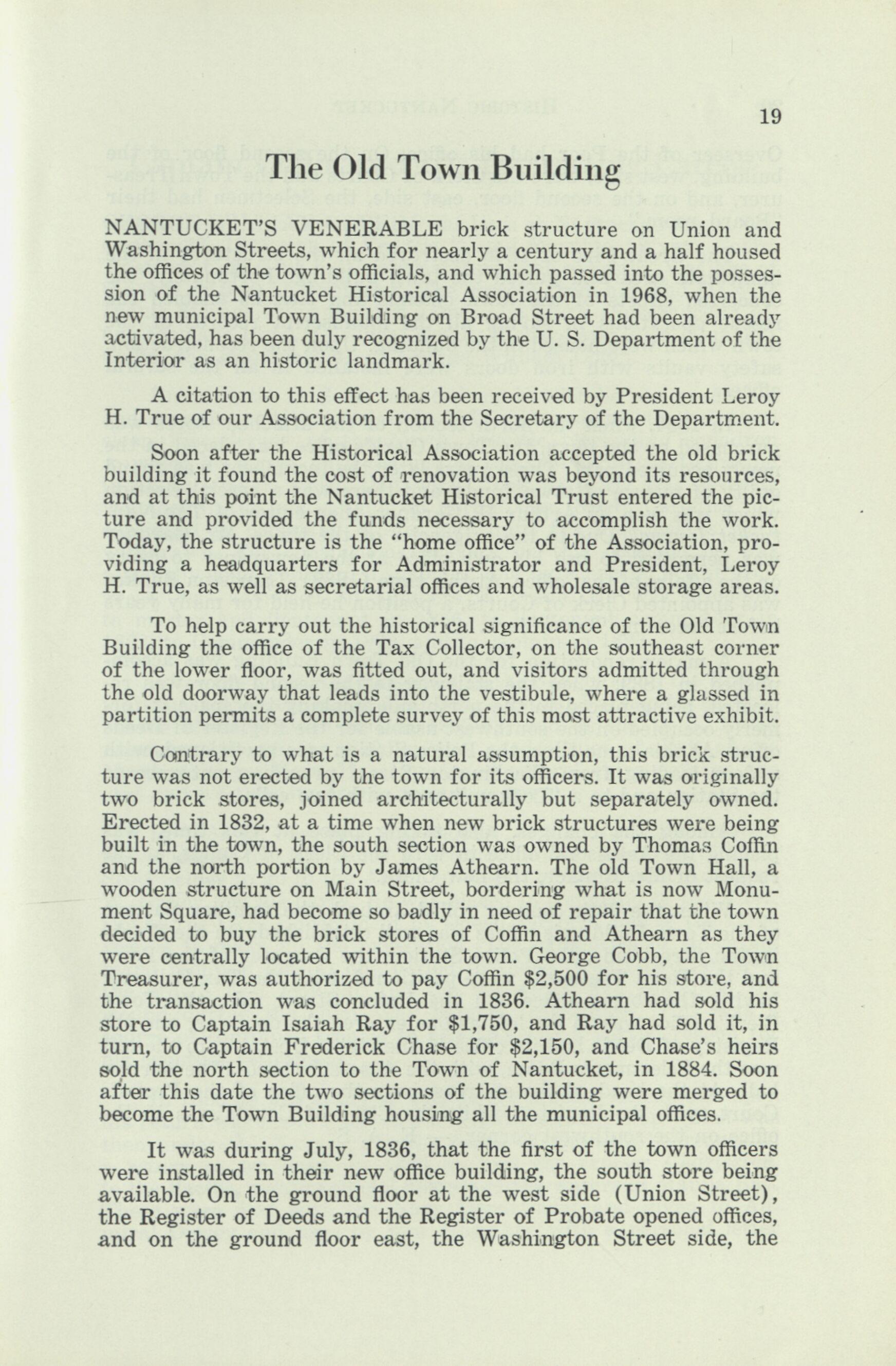
4 minute read
The Old Town Building, by E. A. Stackpole
® o M
Tlie Old Town Building
NANTUCKET'S VENERABLE brick structure on Union and Washington Streets, which for nearly a century and a half housed the offices of the town's officials, and which passed into the possession of the Nantucket Historical Association in 1968, when the new municipal Town Building on Broad Street had been already activated, has been duly recognized by the U. S. Department of the Interior as an historic landmark. A citation to this effect has been received by President Leroy H. True of our Association from the Secretary of the Department.
Soon after the Historical Association accepted the old brick building it found the cost of renovation was beyond its resources, and at this point the Nantucket Historical Trust entered the picture and provided the funds necessary to accomplish the work. Today, the structure is the "home office" of the Association, providing a headquarters for Administrator and President, Leroy H. True, as well as secretarial offices and wholesale storage areas.
To help carry out the historical significance of the Old Town Building the office of the Tax Collector, on the southeast corner of the lower floor, was fitted out, and visitors admitted through the old doorway that leads into the vestibule, where a glassed in partition permits a complete survey of this most attractive exhibit.
Contrary to what is a natural assumption, this brick structure was not erected by the town for its officers. It was originally two brick stores, joined architecturally but separately owned. Erected in 1832, at a time when new brick structures were being built in the town, the south section was owned by Thomas Coffin and the north portion by James Athearn. The old Town Hall, a wooden structure on Main Street, bordering what is now Monument Square, had become so badly in need of repair that the town decided to buy the brick stores of Coffin and Athearn as they were centrally located within the town. George Cobb, the Town Treasurer, was authorized to pay Coffin $2,500 for his store, and the transaction was concluded in 1836. Athearn had sold his store to Captain Isaiah Ray for $1,750, and Ray had sold it, in turn, to Captain Frederick Chase for $2,150, and Chase's heirs sold the north section to the Town of Nantucket, in 1884. Soon after this date the two sections of the building were merged to become the Town Building housing all the municipal offices.
It was during July, 1836, that the first of the town officers were installed in their new office building, the south store being available. On the ground floor at the west side (Union Street), the Register of Deeds and the Register of Probate opened offices, and on the ground floor east, the Washington Street side, the

20
HISTORIC NANTUCKET
Overseer of the Poor had his office. On the second floor of the building, west side, were the Clerk of Courts and the Town Treasurer, and on the second floor, east side, the Selectmen had their "Board room."
The Great Fire of 1846 destroyed all the structures in the immediate area and gutted the town building. Fortunately, the concerted efforts of the town officials and citizens enabled the rescue operations in saving all the manuscript records of the town which were housed in the building. Upon the reconstruction, safety vaults with iron doors were installed in all the several offices.
In 1884, when the north section of the attached stores was purchased by the town, the Town Clerk's office was placed in the newly acquired part. Three years later the incumbent was found guilty of misuse of town funds, and there was a special election which was won by Arthur H. Gardner, then editor of The Nantucket Journal. Due to the exigencies of the times, Mr. Gardner was permitted to use his own office at the newspaper to carry on the affairs of that office. At this time (188,8), Lauriston Bunker was appointed Clerk of Courts, a position he held for many years before becoming Town Clerk.
A major renovation for the Old Town Building was accomplished in 1889, when the stairway to the second floor was relocated, being placed in the north side, making the space it formerly occupied on the southwest usable for the Register of Deeds office. At this same time, the Police Station was partitioned, with a door leading from Washington Street providing entrance to the Station and to a "Lock-up" area with two cells.
Among the changes, also taking place at this time, was placing the Assessors' office in with the Clerk of Courts, at the request of Mr. Bunker, the new Clerk.
When the 20th century rolled around, the familiar pattern of the Town Building's offices was well established. On the Washington Street side, the Police Station, the Overseer of the Poor, and the Town Treasurer were positioned, with the Tax Collector having the corner office. On the Union Street side, the Town Clerk's office was to the left as one entered the doorway, and the Registry of Deeds had its office to the right. Upstairs, to the left was the Selectmen's Room, with the Assessors across the narrow hall. At the head of the staircase was the office of the Probate Court, with the Register, while the Clerk of Courts was in the office on the southwest corner. — E. A. S.











